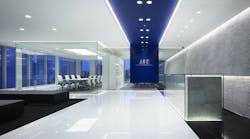Edward Smalley, the Illuminating Engineering Society (IES) 2013 Street and Areal Lighting Conference (SALC) Committee Chair, convened the keynote session of the conference Monday morning and said that with LED-based outdoor lighting you no longer need to compromise in terms of energy efficiency, lifetime, or lighting quality. Indeed, the theme ran through the opening speeches that LEDs offer good efficiency, but that it is networks and controls that can truly allow cities and municipalities to maximize energy and maintenance savings with solid-state lighting (SSL). The messaging followed substantially along the theme of the SALC keynote last year and suggests growing support for a lighting network that acts as a backbone for many services in a municipality.
Mark Lien, director of government and industry relations at Osram Sylvania, addressed a number of issues in his talk but networked lighting was a big part of the talk. Lien listed ten outside industry associations and standards bodies that are exerting force on the SSL industry and noted that five of the ten are focused on interconnect. Examples include the ZigBee Alliance, the TALQ Consortium, and the Connected Lighting Alliance. Lien said, "Interconnectedness is the common thread."
In contrast, only three of the organizations on Lien's list were focused on light-source efficiency. Light quality has also moved beyond source efficiency in importance. Another speaker later on the Monday program concurred. Naomi Miller, lighting designer at the US Department of Energy (DOE) Pacific Northwest National Laboratory (PNNL), said that LEDs are sufficiently efficient that we can afford to waste some of that efficiency now to build better, more comfortable lighting products.
Gianni Minetti, president and CEO of Paradox Engineering, followed Lien and Minetti and really amplified the trend first covered by Niels Van Duinen of Philips Lighting last year. Minetti said 1.2 million new people are moving into new cities each week around the globe. Cities must become more efficient to sustain the growth. He said that smart-city technology, including networked intelligent lighting, could improve energy efficiency by 30% in the next 20 years. That improvement comes on top of more efficient light sources.
Because intelligent lighting offers easily identified savings, Minetti sees lighting as the technology to drive the infrastructure. He said a network designed for lighting can ultimately handle traffic services, emergency signaling, and even pollution controls.
Minetti covered three case studies in San Francisco, California; Paris, France; and Chiasso, Switzerland that have installed wireless multi-service networks. In the Switzerland case, for example, the network carries feeds from video-over-IP traffic cameras along with lighting status and control data; and offers public Wi-Fi. We'll offer more details on those case studies in a later feature article.
The question did arise from several in the audiences as to who owns, installs, and manages such a network within a municipality and how you get different departments to work together. Both Lien and Minetti agreed that such obstacles are part of the growing pains. Both also agreed, however, that there are no technical obstacles. Minett said, "The technology is available today."
.



